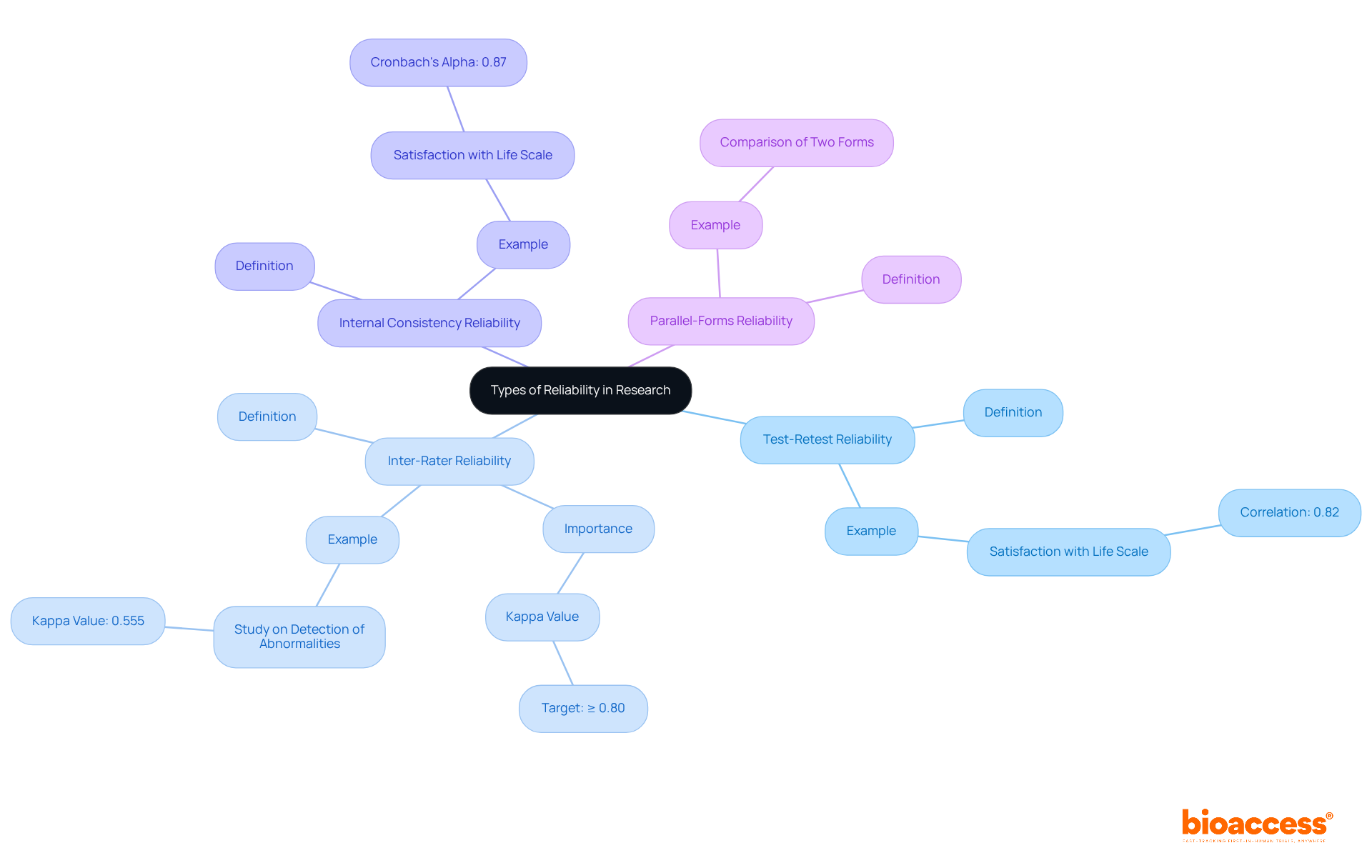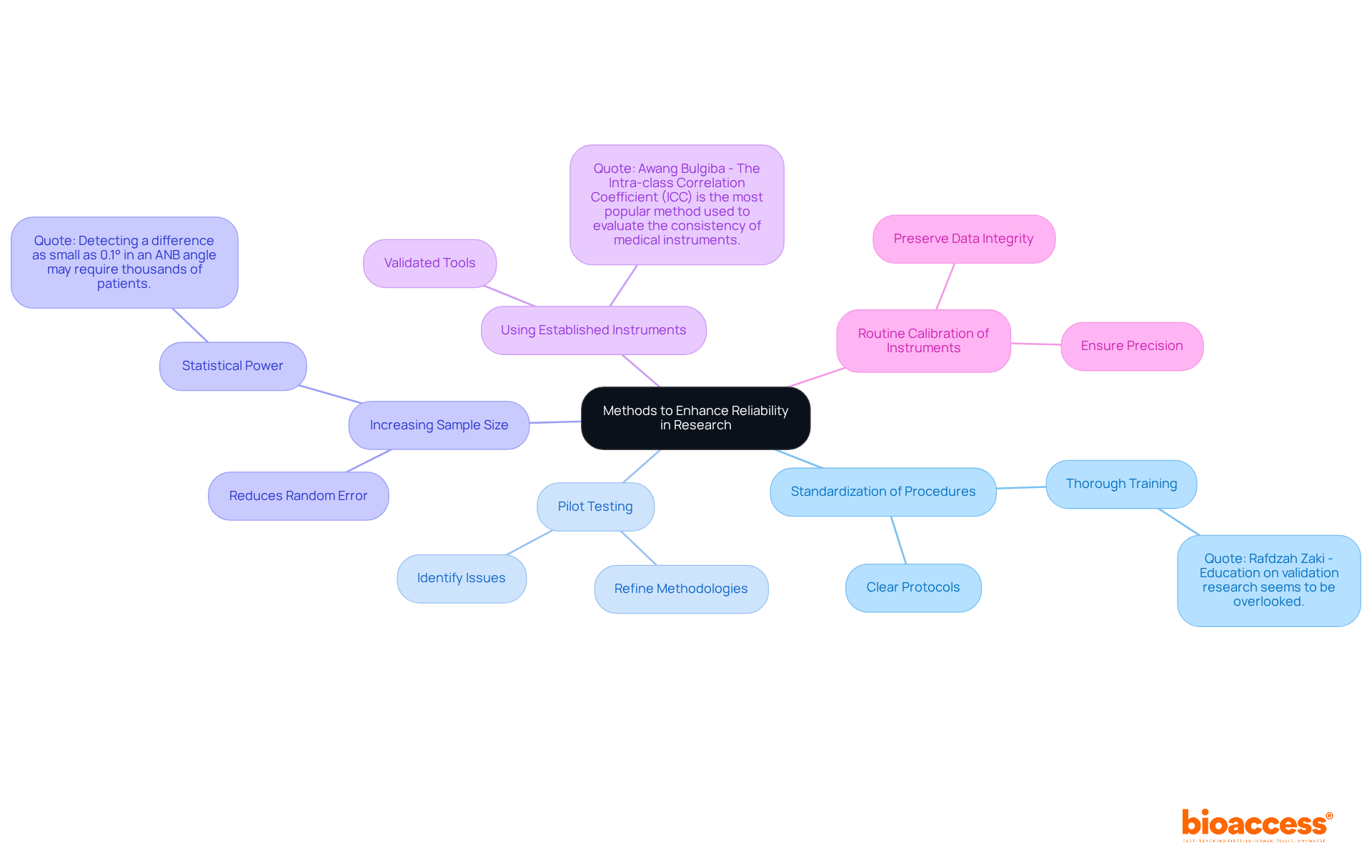


Reliability in science is defined as the consistency and stability of measurements or instruments over time. This concept is essential for ensuring credible research findings. Various statistical techniques and types of reliability, such as:
play a crucial role in assessing dependability. By reinforcing the integrity of scientific conclusions, these methods underscore the importance of reliability in research.
Understanding reliability in science is crucial for researchers who strive to produce credible and actionable findings. This concept not only defines the consistency of measurements but also serves as a cornerstone for the validity of research outcomes. As scientists explore the complexities of reliability, they face the challenge of ensuring that their assessment tools yield stable results across diverse contexts and populations. How can researchers effectively measure and enhance reliability to uphold the integrity of their studies?
In a scientific context, the definition of reliability in science is paramount as it defines the consistency and stability of measurements or instruments over time. This concept reflects how well an assessment tool can yield stable and consistent results across various occasions, contexts, and populations. For example, in clinical studies, a reliable measurement of the Achilles tendon cross-sectional area (CSA) using MRI should produce similar results, regardless of the technician or machine employed. A standard error of measurement (SEM) of 1.3 mm indicates a high level of precision in the scores obtained.
Understanding the definition of reliability in science is crucial for research, as it underpins the credibility of findings and the conclusions drawn from data. Statistical techniques, such as the intraclass correlation coefficient (ICC) and Kappa statistics, are essential for measuring consistency. These tools assist researchers in evaluating the extent to which their measurements are free from random error. Nunnally's recommendations highlight that a consistency coefficient of 0.90 is vital for significant decision-making, underscoring the necessity for high dependability in scientific research, which relates to the definition of reliability in science to ensure valid and actionable results.
Moreover, inter-rater consistency and methods like the split-half technique play a critical role in assessing dependability. The formula X = T + E illustrates the relationship between observed test scores, true scores, and measurement error, further clarifying the concept of dependability in studies. By prioritizing reliability, researchers can enhance the integrity of their work and contribute to the advancement of clinical research.

In the realm of research, the definition of reliability in science encompasses several types that are widely recognized, each playing a crucial role in ensuring the integrity of study results.
Test-Retest Reliability: This type measures the stability of a test over time. Researchers administer the same test to the same subjects at two different points and correlate the scores. A strong correlation indicates robust test-retest consistency. For example, the Satisfaction with Life Scale has demonstrated a test-retest consistency correlation of 0.82 over a two-month period, underscoring its reliability.
Inter-Rater Reliability: This assesses how consistently different raters or observers evaluate the same phenomenon. It's vital in research involving subjective evaluations, such as clinical assessments. Statisticians emphasize that achieving a kappa value of 0.80 or higher is essential for ensuring the dependability of clinical evaluations. A study comparing human and automated detection of abnormalities reported a kappa value of 0.555, highlighting the need for thorough training to enhance inter-rater consistency.
Internal Consistency Reliability: This evaluates the consistency of results across items within a test, often measured using Cronbach's alpha. This statistic indicates how closely related a set of items are as a group. The Satisfaction with Life Scale boasts an internal consistency alpha of 0.87, reflecting strong internal dependability.
Parallel-Forms Reliability: This involves comparing two different forms of a test that measure the same construct. If both forms yield comparable outcomes, the test is considered to have high parallel-forms consistency.
Each category of reliability is essential for the definition of reliability in science and serves a distinct function in ensuring the strength of research findings. The significance of inter-rater reliability, in particular, cannot be overstated, as it safeguards the validity of findings and prevents subjective assessments from distorting results.

The definition of reliability in science is a foundational concept in research, intricately linked yet distinct from validity. Reliability pertains to the consistency of an assessment, while validity evaluates its precision—essentially determining whether a test evaluates what it is meant to evaluate. A dependable metric can yield consistent results that may still be inaccurate; for instance, a scale that consistently reports a weight 5 pounds lighter than the actual weight is reliable but not valid. Conversely, a valid measure must inherently be reliable; if a test produces inconsistent results, it fails to accurately reflect the intended construct. This relationship emphasizes that the definition of reliability in science is a prerequisite for validity, making both concepts essential in the design and evaluation of research studies.
Current discussions emphasize that the definition of reliability in science plays a significant role in affecting validity in scientific measurements. For instance, statistical evaluations of dependability, such as test-retest dependability, necessitate high correlation coefficients (usually exceeding 0.80) to signify that an assessment consistently represents the same construct over time. In clinical studies, the dependability of tools such as the Rosenberg Self-Esteem Scale has been shown through a Pearson's r for test-retest correlation of +.95, reinforcing its validity as an assessment of self-esteem.
Furthermore, the significance of reliability for validity is apparent in various clinical studies. A study examining test anxiety measures found a negative correlation between test anxiety scores and academic performance, supporting the validity of the measure and illustrating criterion-related validity. This emphasizes that without dependable data gathering instruments, the credibility of study results can be undermined, resulting in erroneous conclusions. Therefore, guaranteeing both dependability and validity is crucial for generating credible and trustworthy findings. Moreover, scientists have an ethical duty to implement principles of dependability and validity to enhance public confidence and ensure that study results benefit societal welfare.

Enhancing the definition of reliability in science is essential for producing trustworthy scientific knowledge. Several effective methods can significantly improve the reliability of studies:
Standardization of Procedures: Establishing clear protocols for data collection and analysis is crucial for minimizing variability. Thorough training for researchers and raters ensures uniform application of procedures throughout all phases of the research. As Rafdzah Zaki points out, "Education on validation research seems to be overlooked," highlighting the necessity for adequate training in standardization.
Pilot Testing: Conducting pilot studies allows researchers to identify potential issues with their measures and make necessary adjustments before the main study. This step is vital for refining methodologies and enhancing the overall quality of the research.
Increasing Sample Size: A larger sample size significantly reduces the impact of random error, leading to more stable estimates of reliability. Research involving fewer than 30 participants often struggles to attain sufficient power, increasing the likelihood of incorrect conclusions. In contrast, larger studies can enroll tens of thousands of patients, providing more robust data. For instance, detecting a difference as small as 0.1° in an ANB angle may require thousands of patients, underscoring the importance of adequate sample sizes.
Using Established Instruments: Researchers should prioritize validated tools that have shown consistency in previous studies. Utilizing these tools not only saves time but also enhances the credibility of the research findings, as established instruments are more likely to yield consistent results. Awang Bulgiba emphasizes that "the Intra-class Correlation Coefficient (ICC) is the most popular method used to evaluate the consistency of medical instruments," underscoring the significance of utilizing established methods.
Routine Calibration of Instruments: For research involving equipment, routine calibration is crucial to ensure that measurements remain precise and uniform over time. This practice aids in preserving the integrity of the data gathered and enhances the trustworthiness of the results.
By implementing these strategies, researchers can significantly improve the reliability of their studies. The standardization of procedures is fundamental to achieving reliable results, as it reflects the definition of reliability in science and directly influences the validity of the conclusions drawn from research. Collaboration and adherence to these methods will ultimately lead to more trustworthy scientific knowledge.

Reliability in science stands as a cornerstone for credible research, underscoring the necessity of consistency and stability in measurements and assessments. When researchers ensure that their tools yield dependable results across diverse contexts and populations, they can draw meaningful conclusions that propel the advancement of knowledge. This definition of reliability not only influences the credibility of findings but also intertwines with the validity of assessments, highlighting its essential role in scientific inquiry.
Throughout this article, we have explored several key aspects of reliability, including its various types—test-retest, inter-rater, internal consistency, and parallel-forms reliability. Each type plays a critical role in reinforcing the dependability of research findings, with statistical measures providing the necessary framework to evaluate consistency. Furthermore, the relationship between reliability and validity emphasizes the need for dependable metrics to ensure that research accurately reflects the phenomena being studied.
Ultimately, enhancing reliability in scientific research is vital for producing trustworthy outcomes. Implementing strategies such as:
can significantly bolster the reliability of studies. By prioritizing these methods, researchers not only improve the quality of their work but also uphold the integrity of scientific research, ensuring that findings benefit society at large. Embracing the principles of reliability and validity is essential for fostering public trust and advancing the field of science.
What does reliability mean in a scientific context?
In a scientific context, reliability refers to the consistency and stability of measurements or instruments over time, indicating how well an assessment tool can yield stable and consistent results across various occasions, contexts, and populations.
Why is reliability important in scientific research?
Reliability is crucial in scientific research as it underpins the credibility of findings and the conclusions drawn from data. Reliable measurements ensure that results are trustworthy and can be replicated.
How is reliability measured in scientific studies?
Reliability is measured using statistical techniques such as the intraclass correlation coefficient (ICC) and Kappa statistics, which evaluate the consistency of measurements and help assess the extent of random error.
What is the significance of a consistency coefficient of 0.90?
A consistency coefficient of 0.90 is vital for significant decision-making in research, highlighting the necessity for high dependability to ensure valid and actionable results.
What methods are used to assess inter-rater consistency?
Inter-rater consistency can be assessed using methods such as the split-half technique, which evaluates the agreement between different raters or measurements.
What does the formula X = T + E represent in the context of reliability?
The formula X = T + E illustrates the relationship between observed test scores (X), true scores (T), and measurement error (E), clarifying the concept of dependability in studies.
How can prioritizing reliability enhance research integrity?
By prioritizing reliability, researchers can enhance the integrity of their work, leading to more credible findings and contributing to the advancement of clinical research.